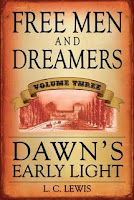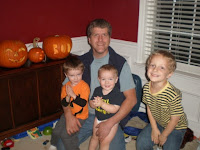
Wow! Laurie Lewis has done it again. Writing as L.C. Lewis, she has just released another action-packed, stuffed-full-of-American-History novel. This is the third in the Free Men and Dreamers series, entitled Dawn’s Early Light. Set during the War of 1812, it’s a continuation of the story of Jed Pearson, plantation owner, member of the Maryland Militia, and man of principle and action.
If you read my review of the two earlier books, you know that in them we met Jed and his wife Hannah as young people, and we followed their rocky courtship, hoping that she would choose him in the face of her parents’ disapproval. In this Early American setting, Ms. Lewis
 let us see the incidents that were shaping not only Jed and Hannah’s destinies, but also the destiny of their young country.
let us see the incidents that were shaping not only Jed and Hannah’s destinies, but also the destiny of their young country.The brilliant thing about this series is that it lets us see how intertwined the affairs of England and America were at that juncture. We see how the lives of families on both sides of the Atlantic were colored by the same incidents, only in different hues because they were seen through a different lens.
Ms. Lewis has also brought the War of 1812 battles surrounding Washington D.C. to life. As a writer, I marvel at her foresight to have written the minor character Marcus O’Mally into the first book and let us get to know him better in the second so that in the third, we can follow his exploits as a bargeman and understand this part of the naval strategy. That’s plotting at its very best.
I also appreciated the glimpse of Dolly Madison. After finishing Dawn’s Early Light, one of the things high on my To Do List is to get her biography and read it.
Though this is one of a series of books, it can stand alone. Ms. Lewis has provided a list of the cast of characters, and as they are introduced into the narrative, she unobtrusively reminds us who they are and how they have been important to our main characters.
You can buy Dawn's Early Light on Amazon, Deseret Book, Seagull Books or order it from your favorite book store.
I can’t wait to read Number Four in the Free Men and Dreamers Series. If you read Dawn’s Early Light (and you must), you’ll know exactly why.
~~~~~~~~~~~~~~~~
Follow this blog! I have yet to make good on my promise to teach you how to make flour tortillas, and I'm also going to blog about Navajo Tacos, so hang around.



